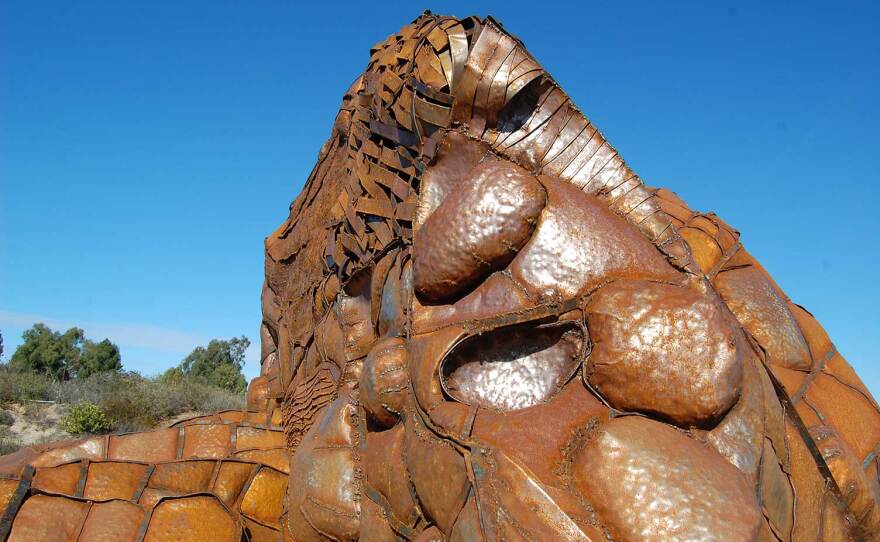In Beatriz Cortez's new outdoor residency at Lux Art Institute, the sculptor uses raw metals to explore place, lost languages and immeasurable movement. The exhibition is set up outdoors to be COVID-safe, but it is also intended to transform with the elements.
"In reality, steel is coming from the ground, is extracted from the ground, is organic. It's alive. And so I'm thinking a lot about the lives of matter and the lives of materials, and how matter becomes an archive," the El Salvador-born and Los Angeles-based artist said.
How to view 'Glacial Erratic'
Visitors can make appointments to walk through the outdoor exhibition in-person at the Encinitas art space, Thursdays through Saturdays from 2 to 5 p.m., Jan. 29 through Mar. 28. Additional works will be installed throughout the residency. Free.
Accessibility note: The exhibition involves a 0.25 mile hike, uphill on a trail. Closer parking is available, but a moderate climb on foot is unavoidable.
Cortez works with unsealed steel — a ton of it, to be exact — and this installation relies not on steel's hardness or effectiveness as a building material, but on its vulnerabilities. "I'm more interested in the beautiful ways in which it reveals its organic nature," she said.
Cortez's work, titled "Glacial Erratic," was first installed as part of the Frieze Sculpture exhibition in Rockefeller Plaza in New York City, where it was on display outdoors for several months last fall.
"It will be outdoors receiving the rain and receiving the visits of birds and all of us that will be visiting, and so its interaction with the atmosphere that's made by all of us breathing close to it, et cetera, is going to impact the way in which the sculpture will be also changing."
"Glacial Erratic" will be installed in San Diego with the marks and transformations of the work's sojourn in New York in place. And at the end of March, when the Lux installation is removed, it will take the San Diego effects with it to its next destination.

The full outdoor exhibition — a shared residency among Cortez and five contemporaries she invited to join her — is titled using an unnameable glyph. The symbol is from the lost language of the indigenous Olmec people from the Veracruz region of Mexico.
Cortez describes the glyph as a snake taking the form of a bump in the landscape. The Olmec people saw the mountains as objects in motion, Cortez said, and were better able to conceptualize a glacial pace of change and movement than modern civilizations.
"The show is about the motion. Of everyone, all of us on the mountain, but also the mountain itself," Cortez said.
In the Aztec language, the word for the glyph is "tepetl." In the Mayan language, it's "witz." Cortez said in English we might use the word "hill" or "mountain," but mountains are static to modern humans. To the Olmec, the glyph meant something broader, something moving, and something much harder to conceptualize in the current era.
"On the one hand, I think it's important that the title of the show presents a problem. We don't know how to pronounce it. We have to use our different colonial languages, English, or Spanish to say it because we don't have a way to know the original term," said Cortez. "There's so much that language preserves about our own migrations and our own transformations."
The exhibition aims to spotlight how indigenous languages are disappearing, but Cortez also wants people to think about future languages. She wants us to imagine. Cortez draws on ideas of nomadism — nomads across different spaces, but also through time and identities. It's a bigger picture of movement and nomadism that honors the celestial, zoomed-out understanding of the Olmec and their mountains.
"I, myself as an immigrant, as a person who's constantly surrounded by people who speak Spanish and English and who oftentimes finds it easier to say half of the sentence in Spanish and half of the sentence in English — we see language transforming itself," said Cortez.

The exhibition, nestled on a small hillside accessible via a short, quarter-mile hike from the gallery, will also transform throughout the next two months. While it opens on Saturday, Jan 29, five additional Los Angeles-based artists will take residence at the space and install new works progressively.
In early-February, Christian Tedeschi will install a sculpture using stones made from old clothes and resin. By mid-February, Cortez will install more works, followed by adobe-based installations from rafa esparza. By mid-March, Kang Seung Lee's additions will include ceramics made with clays from the ground in California, his hometown in Seoul, South Korea, and in the United Kingdom.
"It's like bringing those mountains to visit this mountain, or making the mountains move and travel the way that humans do or to make visible the fact that every time we traveled from one mountain to the other, we're really bringing particles of one mountain to the other," Cortez said. "We are part of this motion of the planet, even if we're not able to see it."
Pavithra Prasad will install a performance piece in late March, and to close out the project, Candice Lin will install a piece inspired by amulets and serve as a sort of wishing stone for visitors.
"I think it will be beautiful, especially for people who are close by, to be able to come several times and see it as it's changing," Cortez said.






